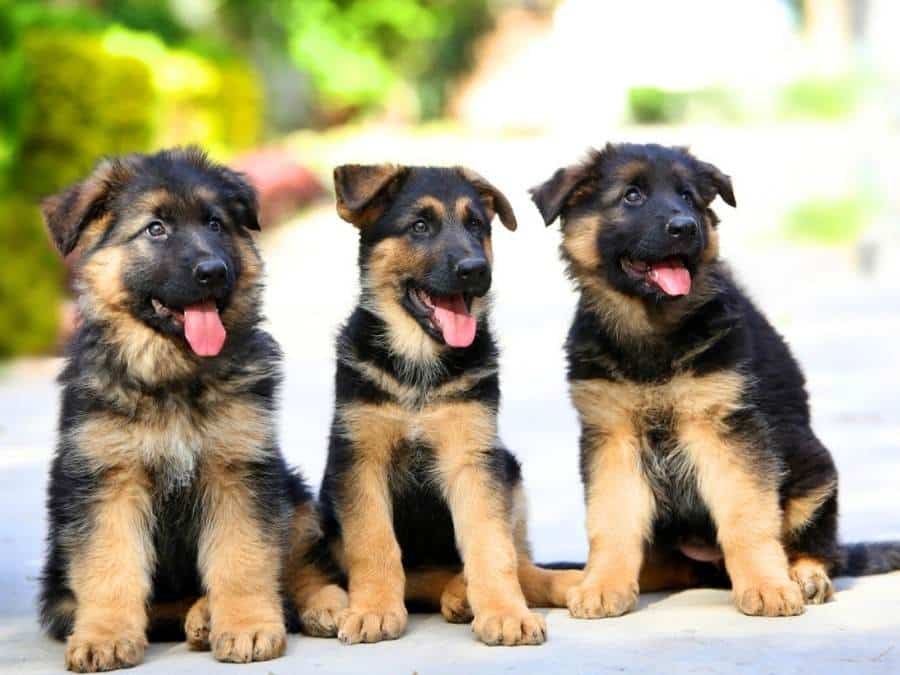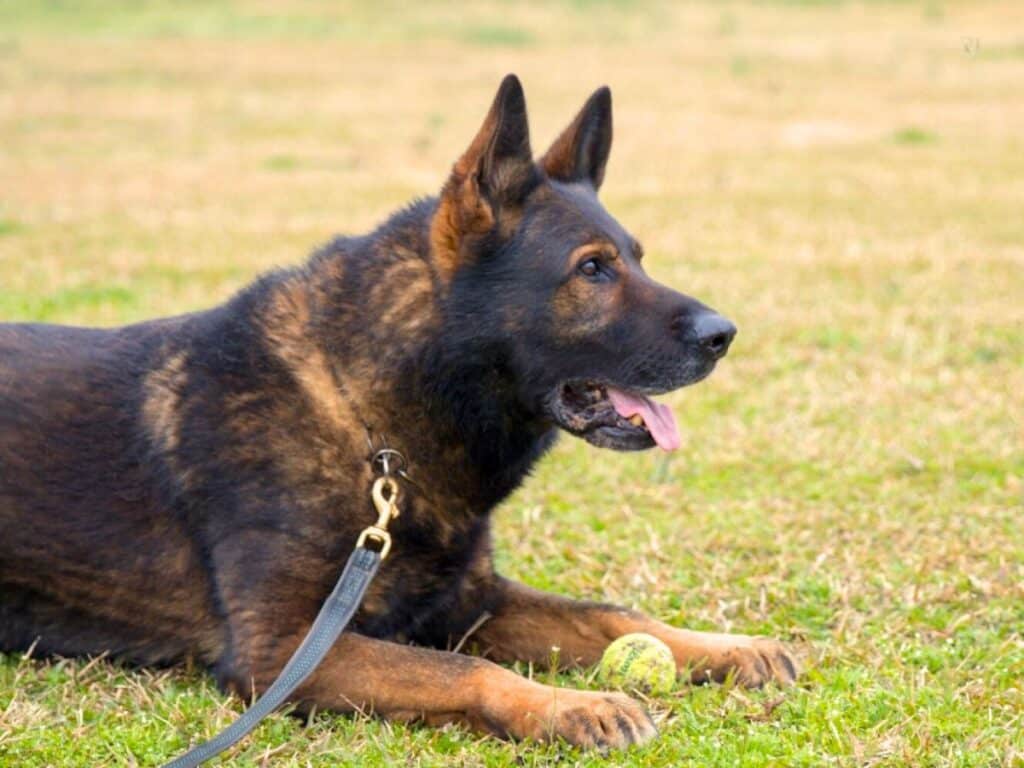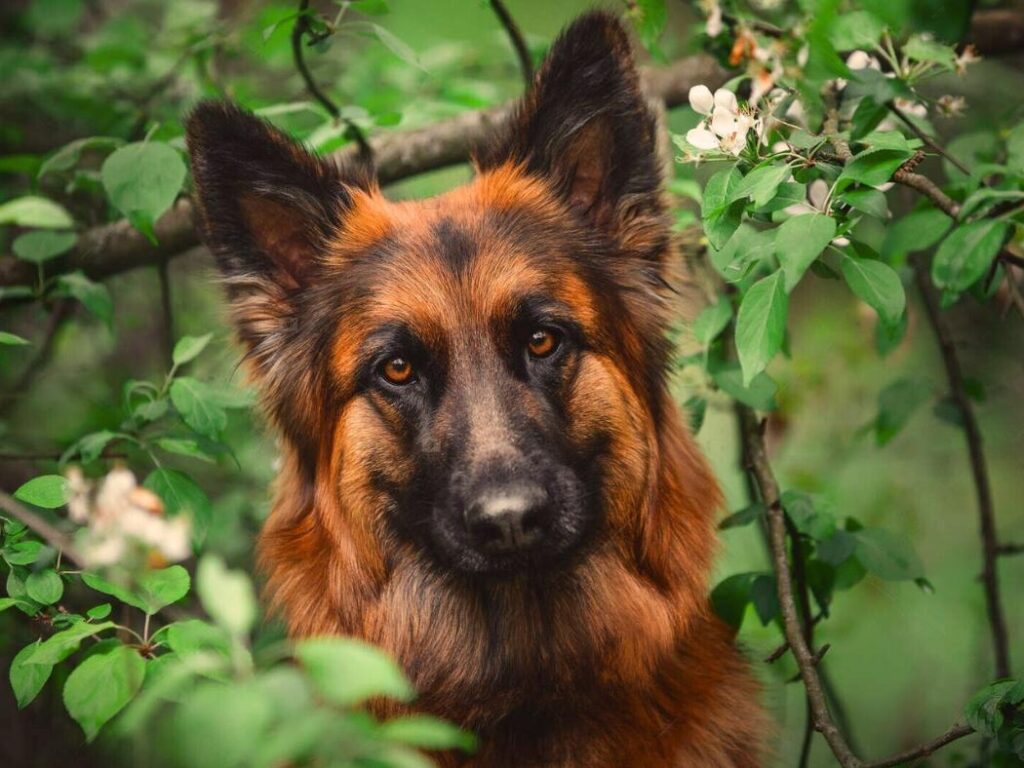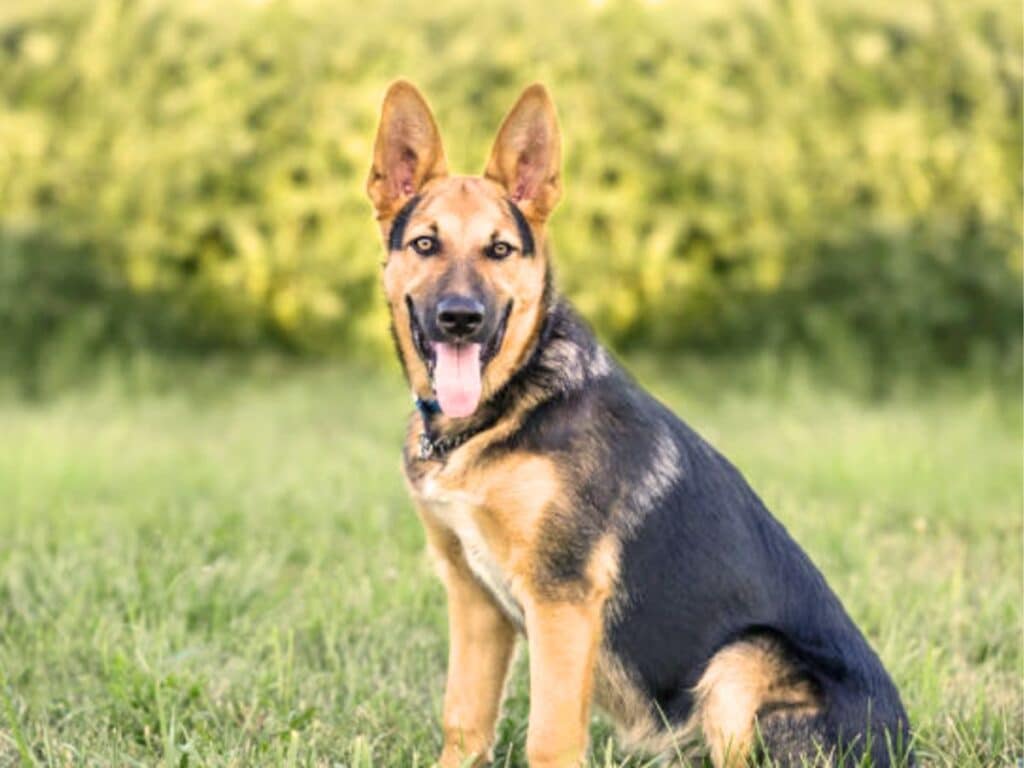Do German Shepherd puppies change color? Well, German Shepherd puppies often undergo significant changes in their coat color as they grow. It’s a natural occurrence that adds to the uniqueness of this beloved breed.
The journey from a tiny, fluffy ball of fur to a majestic adult with distinct markings is truly captivating. As breeders carefully select mating pairs for desirable traits and dog shows highlight the breed’s standard colors, it becomes even more intriguing to witness the range of variations that German Shepherd puppies can exhibit.
Do German Shepherd Puppies Change Color?
Yes, German Shepherd puppies can experience changes in coat color as they mature. The coat color of a German Shepherd puppy can change quite a bit during its first year of life. The color changes are more noticeable in certain color patterns, such as black and tan or sable.
For example, a black and tan German Shepherd puppy might be born with a mostly black coat with tan markings on the eyebrows, cheeks, chest, legs, and underside of the tail.
As they grow, their tan markings might become more pronounced and spread out. The black areas might also lighten a bit.
By the time they reach adulthood, their coat color will have settled, but there can still be subtle changes over time due to factors like seasonal shedding and exposure to sunlight.
Sable German Shepherds, which have a mix of different shades of the same color, can also show changes in the distribution and intensity of their coat colors as they age.
It’s important to note that not all German Shepherds will experience dramatic color changes, and the extent of color change can vary from one individual to another.
Why Do German Shepherd Puppies Change Color?

Well, the truth is that various factors contribute to a puppy’s color transformations, including genetics, age, diet, environment, hormonal influences, and even sunlight exposure.
1. Genetics
These dogs possess a wide range of genes that interact to create unique patterns and shades in their coats. Different combinations of genes can result in various coat colors such as black and tan, sable, bi-color, or all-black.
Just like humans inherit traits from their parents, German Shepherds also inherit certain genes that determine their coat colors. The specific combination of genes they receive from both their mother and father will influence the pigmentation of their fur as they grow older.
2. Pigment production
The two main pigments responsible for coat color in German Shepherds are eumelanin (black pigment) and phaeomelanin (red/yellow pigment).
As puppies mature, their bodies start producing these pigments in different proportions, leading to changes in coat color. The distribution and intensity of these pigments can shift, altering the appearance of the coat.
3. Age
At birth, most German Shepherd puppies have a distinct appearance with lighter fur tones. However, as they grow older and reach adolescence around six months old, their true adult coat begins to emerge.
It is not uncommon for GSD puppies to experience variations in shade or intensity before settling into their final adult coloration by around two years old.
4. Diet
Believe it or not, what your German Shepherd puppy eats can impact the development of its coat colors.
A well-nourished puppy will have a better chance of developing a vibrant and lustrous coat. Conversely, a poor diet lacking in essential nutrients may result in dull or lackluster fur.
5. Sunlight exposure
Prolonged exposure to sunlight can cause the dark pigments in a German Shepherd’s coat to fade or become lighter. This phenomenon is more noticeable in areas with intense sun rays or during summertime when dogs spend more time outdoors.
However, it’s important to note that this fading effect is temporary and does not alter the genetic makeup responsible for their permanent coat color.
6. Hormonal influences
Hormonal changes that occur as puppies mature can also influence coat color. The hormonal shifts during adolescence can impact the way the coat’s pigments are distributed, leading to further color variations.
German Shepherd Puppy Color Change Timeline

German Shepherd puppies go through a series of coat color changes as they age. Here’s a general timeline of how their coat color might change over the first few months:
Birth to 2 Weeks:
German Shepherd puppies are usually born with a very faint, often almost entirely black, coat. They might have small patches of tan or cream on their paws, muzzle, and eyebrows.
2 to 4 Weeks:
During this time, the tan or cream patches on the puppy’s coat become more noticeable, particularly around the eyes, ears, and paws. The black areas may still dominate the overall coat color.
4 to 8 Weeks:
The tan or cream patches continue to grow and become more defined. The puppy’s coat might start showing a more distinct two-tone appearance, with a combination of black and tan.
8 to 12 Weeks:
The tan areas on the puppy’s coat continue to expand, and the black areas may start to recede. The puppy’s coat may begin to resemble the traditional “saddle” pattern of an adult German Shepherd, with a black saddle-like area on the back and a lighter underbelly and legs.
3 to 6 Months:
The puppy’s coat transformation becomes more apparent during this period. The black areas may continue to fade, while the tan or cream areas become more prominent and cover a larger portion of the body. The transition from puppy coat to adult coat becomes more evident.
6 to 12 Months:
By this time, the puppy’s coat should be closer to its adult coloration. The black areas may have turned into a rich tan or reddish-brown color, while the tan or cream areas remain light. The coat may still be changing, but the transformation is largely complete.
1 Year and Beyond:
Around the age of 1 year, most German Shepherds have fully developed their adult coat colors. The black portions of the coat are typically deep tan or red-brown, and the tan or cream areas maintain their lighter coloration.
Remember that coat color changes can vary from puppy to puppy, and genetics play a significant role in determining the final coat color of a German Shepherd. Additionally, there are variations within the breed that might lead to different coat color patterns, such as sable or bi-color coats.
Common Color Patterns in German Shepherds

German Shepherds are known for their striking appearance and unique color patterns. Here are the 11 German Shepherd colors that have been recognized by the AKC.
1. Black and Tan
One of the most recognizable and traditional color combinations seen in German Shepherds is the black and tan pattern. This dominant color scheme features a rich black coat with distinct tan markings on specific parts of the body, such as the legs, chest, neck, and face.
The contrast between the deep black fur and warm tan accents creates a visually stunning effect that is often associated with this breed.
2. Sable Coats
Another common color variation found in German Shepherds is the sable coat. Sable coats showcase a beautiful blend of different colors, ranging from light gold to dark brown or even grayish-black tips on each hair strand.
This unique texture gives them an almost “wild” appearance, reminiscent of wolves roaming through forests.
3. Bi-Colors
Bi-color German Shepherds have large areas of solid black combined with tan markings on specific parts of their bodies. These distinctive markings typically appear on the legs or face, creating a striking contrast against their predominantly black coats.
4. Solid Black
In some cases, German Shepherds may have a solid black coat without any tan or sable markings. While less common than other color patterns, solid black shepherds possess a sleek elegance that sets them apart from their counterparts.
5. Black and Red
The Black & Red color pattern is similar to black and tan, but the tan or reddish-brown areas are more vibrant and intense, often giving the dog a more fiery appearance.
6. Black and Silver
Black and silver German Shepherds have a black coat with silver markings. These markings can appear on the face, legs, chest, and underside. The silver color adds an additional layer of contrast to the traditional black and tan appearance.

7. White
Although less common, white German Shepherds are recognized. They have a predominantly white coat, with possible tan or cream markings.
8. Liver
The liver coloration in German Shepherds is a rich and deep brown, creating a distinctive and unusual appearance. This unique hue adds a touch of individuality to the breed’s characteristics.
9. Blue
Blue German Shepherds display a bluish-gray coat that stands out for its rarity. The cool undertones of their coat contribute to their enigmatic and striking presence.
10. Gray
A less common color variant, gray German Shepherds exude an air of mystery and uniqueness. Their coat may vary in shades of gray, lending them a distinctive charm.
11. Black & Cream
This color pattern combines the richness of black with the softness of cream. The contrast creates a striking visual appeal, highlighting the dog’s noble and distinctive presence.
Also, there are certain rare German Shepherd colors such as the Isabella, Panda, and Sable Merle. But it’s important to note that some of these rare colors can be associated with specific health concerns or may not be accepted by breed standards in some organizations.
How To Predict the Future Coat Color of a GSD Puppy
While it’s not always possible to accurately predict the exact color of a GSD pup, you can make educated guesses based on the coat colors of the puppy’s parents and their genetic makeup. Here’s a general overview of how to predict the future coat color of a GSD puppy:
1. Examining the parents’ coat colors
The genetics behind the different colors in GSDs involve a combination of dominant and recessive genes. For example, if both parents have black coats but carry recessive genes for sable or bi-color coats, there is a possibility that their puppies may inherit those traits.
However, it’s essential to remember that genetic inheritance isn’t always straightforward. Sometimes unexpected variations occur due to hidden genes or mutations. Therefore, while examining parental coat colors can give us some insights into potential outcomes, it doesn’t guarantee accuracy.

2. Genetic testing and its limitations
By analyzing DNA samples from both parents and offspring, genetic testing can provide information about the likelihood of specific coat colors appearing in future generations. However, it’s important to note that genetic testing is not foolproof and may not be able to account for all possible variations.
Genetic testing cannot predict environmental factors that may influence coat color changes. Factors such as exposure to sunlight, seasonal variations, and the puppy’s individual development can all play a role in how their coat color evolves over time.
3. Observing early signs of pigmentation changes
Puppies are born with a soft and often lighter-colored puppy coat that gradually transitions into their adult coat.
During this transition period, it is not uncommon for puppies to experience changes in their fur color as they shed their puppy coat and develop their adult coat. These changes can occur due to the activation or suppression of certain genes responsible for pigmentation.
For example, a German Shepherd puppy with a black coat may start showing patches of tan or sable as they grow older. These subtle shifts in color can give us clues about what the future holds for their adult coat.
Final Words
In conclusion, the question of whether German Shepherd puppies change color as they grow is an intriguing one that underscores the complex interplay of genetics and development. As these puppies transition into adulthood, shifts in coat color are often observed due to factors such as genetics, pigmentation changes, and the influence of various genes.
While many German Shepherds may undergo noticeable shifts in their coat colors during their early months, it’s essential to remember that predicting these changes with absolute certainty can be challenging.
Frequently Asked Questions (FAQs)
1. Can I predict the exact coat color my German Shepherd puppy will have as an adult?
Predicting the precise coat color of a German Shepherd puppy as they mature is challenging. While certain genetic markers can give some indication, it’s impossible to guarantee an exact outcome. Embrace the unpredictability and enjoy watching their colors change over time.
2. Will my German Shepherd puppy’s coat continue changing throughout its life?
While most of the dramatic changes occur during their first year or two, German Shepherds can experience subtle shifts in their coat color throughout their lives. These changes are usually influenced by factors such as age, health conditions, or hormonal variations.
3. Can I influence my German Shepherd puppy’s coat color through diet?
Diet alone cannot significantly alter your German Shepherd puppy’s natural coat color. However, ensuring they receive balanced nutrition will contribute to overall coat health and shine.
4. Are there any specific grooming practices I should follow for my German Shepherd puppy with changing colors?
Regular grooming is essential for maintaining your German Shepherd puppy’s coat health, regardless of color changes. Brushing their fur regularly, providing occasional baths, and keeping an eye out for any skin issues will help keep their coat in optimal condition.




